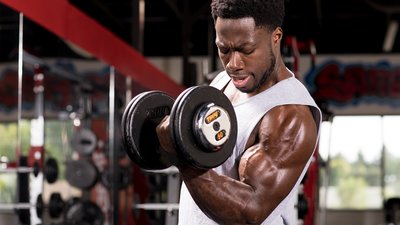Time to train biceps. What do you do? The old bodybuilding way of doing things says start with heavy work in the 6-10 rep range, then hit the dumbbells for sets of 8-12, and finish with forearm-heavy accessory work like hammer or reverse curls. What could go wrong?
Plenty, believe it or not. Too much poorly programmed volume, and using the wrong biceps exercises at the wrong times will not only lead to poor arm development, but also pissed off elbows and shoulders. Having your arm workout put you on the shelf—now that's a tragedy.
Fortunately, there's a way to hammer your biceps with loads of volume and relative intensity, while keeping your wings healthy and functioning in the process. It all comes down to the order of your biceps exercises.
Structure your biceps work in these three blocks to unlock your growth potential while protecting your elbows and shoulders from aches and pains. Here's how to structure the best biceps training day of your training career.
Step 1: "Prime" the Deep Stabilizers
Stabilizers? What, are we doing deadlifts? Believe it or not, this approach is just as important for the biceps.
Especially if you're undertaking an arm-specific training day, a more generalized upper-body warm-up is usually not enough to prepare the shoulders and elbows for the immense amount of volume they'll have to endure. While using a comprehensive upper-body routine like my six-phase dynamic warm-up sequence is a great first step, you should still strategize the order of the types of biceps exercises to prioritize pain-free arm growth.
Since the goal is to increase tissue temperatures and lubricate both the shoulder and elbow joints with synovial fluid—aka the motor oil of the joint space—I recommend "priming" two of the primary stabilizing muscles of the arms first: the brachioradialis and brachialis.
The brachioradialis muscle is one of the most prominent muscles of the forearm that aids the elbow in flexion (raising) while also stabilizing the shoulder joint. The brachialis is a primary stabilizer of the front side of the shoulder, located underneath the biceps group, and also helps flex the shoulder. Both of these muscles can be targeted simultaneously using neutral-grip or reverse-grip hand positions, in exercises such as hammer curls or reverse curls.
In order to link the brachioradialis with the brachialis optimally, focus on two technique tips:
- Focus on hard contractions of the forearm, flexing the elbow first. This is almost unavoidable provided you're not using way too much weight.
- Finish off the top of the range of motion with slight shoulder flexion—not as far as a front raise, but a few inches at least.
Don't worry about the shoulder "taking over" the movement with this slight raise. It's still your arms working! But this small addition will go a long way to not only enhancing your mind-muscle connection, but preparing you for the more intense biceps training to come.
Programming: Stick with higher-end hypertrophy rep schemes here, doing a few sets of 1-2 movements between 10-20 reps. Focus on quality of contractions over external loading.
Step 2: Hit Biceps-Focused Movements With a Twist
Your biceps and all the muscles around them are now ready for action. Let's give them some.
Wait! Put down that barbell and pick up a dumbbell. Here's why: The biceps aren't a one-muscle group that works in a single plane of motion. Rather, the biceps are two sister muscles that have a common attachment point across the front side of the elbow joint, but differing attachments up into the shoulder.
In action, this means that training this group with rotation allows this dual-belly muscular region to be targeted more effectively. The tools of choice for this part of the workout are dumbbells, or any tool that can allow the right and the left arms to move independently of one another. The more degrees of freedom that we allow through rotational planes of motion with biceps training, the better the quality of the contraction, and the higher muscular activation you'll be able to tap into.
Since the biceps have been shown to have the highest rates of activation with a supinated (palms-up) hand position, ensure you rotate into supination with the exercises you choose for this block of the workout. Traditional rotating dumbbell curls, alternating curls, or cross-body curls are all great options here.
Programming: Since muscular and neural activation of the biceps is the focus now, bump up the weight slightly from step one, performing 1-2 movements in classic hypertrophy rep ranges of between 10-15 reps. Using a weight that results in failure in this range is sufficient to allow you to keep the feel of the movement and the contraction, while demanding tension out of the muscle tissues as well.
Step 3: Finish the Biceps From an Isolated Stretch Position
The biggest mistake lifters make in their biceps training is going right into the big movements of the day that start from a stretched position, use heavy loading, and have fixed hand positions. I'm referring to barbell curl variations that place the elbow in extreme extension forcing the biceps to contract hard from a dead stop position.
This doesn't mean barbell biceps curls, preacher curls, and machine curls are inherently dangerous to the elbow or shoulder joint—they're not. There is absolutely a place and time to grab a barbell and knock out heavy curls in the 6-10 rep scheme. But you'd better make damn sure that you have prepared your joints, tendons, and soft tissues to bear the stress that you are about to place on this region.
Training the biceps out of a stretch should be the last type of movement you include on an arm or biceps training day. Everything else you've done up to this point has helped you earn the right—and cover your ass against training-related injuries—to train the big barbell or EZ-bar movements.
Finishing off an arm day out of the stretch with heavier loading—or at least in slightly lower rep ranges—is a safe and effective way to target muscle and strength gains. It's also far safer due to the natural pre-fatigue that has set in to the biceps and arms in general before you get to the last 1-2 movements of the day.
Yes, you'll have to go lighter in this approach than you would if you just waded in and started curling heavy. But remember, pain-free training isn't always about the load you move, but rather the muscular response and adaptations it creates. Your goal for biceps training—as with every other muscle group—needs to be, "Hammer the muscles while sparing the joints."
That mindset, in combination with this three-stage sequence of biceps training will lead you to the promised land of arm growth, minus the aches and pains that are too often part of going hard on biceps training.
Programming: Hit 1-2 movements for sets of 6-10 or 8-12, and walk out of the gym feeling every fiber of your biceps, but not your elbow or shoulder.

